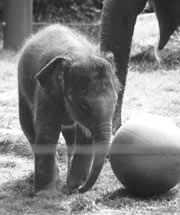SO, SALMON AREN’T the only important Puget Sound fishes in trouble. The National Marine Fisheries Service (NMFS) is considering listing seven marine species, including Pacific cod, herring, hake, pollack, and rockfish, as threatened or endangered (see “Scraping the Bottom,” 8/19). And how do state officials and federal scientists propose to deal with the rapidly emerging threat to the Sound’s finny residents? In part, by breeding more fish to boost the depleted stocks. Legislators have provided the money, NMFS researchers are providing the baby fish, and the stage is set for the first-ever nonsalmonid hatchery program on Puget Sound. And that has other fish experts very, very worried.
“The Legislature, in its infinite wisdom, has seen what a great success our hatchery program for salmon was and says we should do the same thing for some marine fish,” quips Ray Hilborn, a fisheries professor at the University of Washington and long-time critic of salmon hatcheries. Those hatcheries are now widely decried for driving down wild runs by pumping out millions of oversized young salmon that spread diseases, degrade gene pools, and nudge aside, out-eat, or simply eat their wild counterparts. Nevertheless, the Legislature has directed the state Department of Fish and Wildlife (DFW) to crank out ever more hatchery salmon—and to look into likewise supplementing declining bottomfish. And the NMFS lab at Manchester, Washington, has devised the technology to make that possible.
First out of the lab (and the first successfully raised anywhere) are 1,000 young lingcod, a coveted sport and commercial species. Lingcod grow big, taste good, fight hard, and look fierce, with gaping jaws and scary front teeth. They’re also voracious top predators whose prey includes rockfishes that may soon be listed as endangered. That’s just one reason Hilborn thinks releasing lingcod is a dangerous idea. The main question, he says, is whether hatchery-raised fish would actually “augment” wild stocks, as proponents claim, rather than “just replacing overharvested wild production”—or, worse yet, “displacing” it. “My big concern is that hatcheries will become an alternative to saving wild stocks. Instead of doing something hard—reducing catches, preserving habitat—we’ll take the easy route and just raise more fish.” Hilborn says that marine hatcheries are seen in the field as “just displaced salmon-hatchery people trying to find work.” If so, that would be a fine historical irony: In the 1980s, many displaced salmon fishers switched to lingcod and other bottomfish—driving their numbers down too.
The lingcod project has opened a rift between fisheries managers and hatchery operators—a rift that runs straight through the Department of Fish and Wildlife itself. “There’s been a debate in the agency on marine hatcheries,” says Wayne Palssen, the DFW’s senior biologist for Puget Sound groundfish. Indeed, it was worried DFW staffers who alerted Hilborn to the project, and he’s become a lightning rod for their concerns. Many of them will probably sign a petition urging caution on marine hatcheries that he’s circulating and planning to send to Congress, where the hatchery effort will seek further funding.
“You can use hatcheries for a lot of different purposes,” notes Palssen. “It’s not quite clear which the current proposal is. You have to ask, ‘Why’s this being done? What management goal does it fulfill?'” Palssen adds that we simply don’t know how far released lingcod might stray or how they might affect the wild gene stock: “We don’t have the genetic knowledge for lingcod that we have for salmon.” And he notes that hatcheries cost “a lot of money” (which fisheries managers would doubtless like a shot at). Again, “We don’t know enough to evaluate the costs and benefits.”
Lee Blankenship, the DFW scientist spearheading the lingcod project, says these fears are premature. “We haven’t decided whether to release these fish yet,” he says; so far, they’re merely a “research tool,” and any move to stock them would depend on just the sort of data Palssen and Hilborn call for. To that end, Blankenship says, his team is now examining the DNA of various lingcod populations—work that will aid management as well as enhancement. Conrad Mahnken, the director of the NMFS’s Manchester lab, offers similar reassurances: “There is no proposal for [full-scale] lingcod hatcheries. The people complaining about this are complaining about research. The only way to know what the effects might be is to do these kinds of experiments.”
Still, it’s not hard to see where this research points. Blankenship is a prominent advocate of what a paper he wrote calls “Responsible Marine Fish Enhancement.” And because “traditional management hasn’t worked,” he sees hatcheries as a necessary aid to restoring many fish stocks—eventually. “We could spend 10 years just studying lingcod. We don’t have any plans to do any other species at this time.”
But Mahnken says his federal lab is already looking at rearing rockfish and halibut, and that British Columbia and the Makah Tribe also have their sights on marine fish enhancement. Once you roll the technology out, it’s hard to roll it back.







